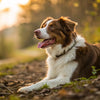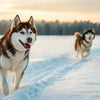How Long After Exercise Should I Feed My Dog? Understanding the Perfect Timing for Optimal Health
- Houndsy
Table of Contents
- Introduction
- The Importance of Meal Timing
- Tailoring Feeding Schedules to Your Dog's Activity Level
- Feeding Strategies for Active Dogs
- Hydration Matters
- Observing Your Dog’s Behavior
- Conclusion
- FAQ
Introduction
As dog lovers, we all want the best for our furry companions. Did you know that improper meal timing can significantly impact your dog’s health? According to veterinarians, feeding your dog too soon after exercise can lead to serious health issues, including digestive problems and bloat—a potentially life-threatening condition. This raises an important question: how long after exercise should we feed our dogs?
In this blog post, we will dive deep into the relationship between exercise and proper feeding schedules for dogs, helping you make informed choices that enhance your pet's well-being. We'll explore the science behind digestion, the risks associated with poor timing, and practical feeding strategies to ensure your dog receives the optimal nutrition they need.
By the end of this article, you’ll gain valuable insights into setting a healthy feeding routine that complements your dog’s active lifestyle. So, let’s reflect on our own pet feeding habits and explore how we can improve them to keep our beloved companions healthy and happy.
The Importance of Meal Timing
The Digestive Process
Understanding how a dog’s digestive system works is crucial to determining the best feeding schedule. Dogs typically digest food at a slower pace following physical activity. This is because exercise diverts blood flow away from the digestive system, which can slow down the process of breaking down food. After exertion, the digestive system needs time to settle and process nutrients effectively.
Effects of Improper Timing
Feeding your dog too soon after exercise can lead to a range of issues, including:
- Bloat (Gastric Dilatation-Volvulus - GDV): This serious condition occurs when the stomach fills with gas and twists, cutting off blood flow. It is most common in deep-chested breeds like Great Danes and Boxers, but any dog can be at risk.
- Digestive Upset: Overeating or eating too soon after exercise can lead to vomiting or diarrhea, as the stomach struggles to process food while still recovering from physical activity.
- Dehydration: If your dog is still panting and hot from exercise, feeding them immediately may lead to dehydration or discomfort in digestion.
Recommended Waiting Times
So, how long should we wait after exercise before feeding our dogs? Most pet experts recommend waiting at least 30 to 60 minutes after moderate to intense activity before offering food. This allows the dog’s body to cool down and its digestive system to prepare for the meal.
Tailoring Feeding Schedules to Your Dog's Activity Level
Assessing Exercise Intensity
The duration of the wait time can depend on the intensity of the exercise. For example:
- Light Exercise (e.g., casual walks or playtime): A waiting period of about 30 minutes may be sufficient.
- Moderate Exercise (e.g., jogging or playing fetch): A waiting time of 45 to 60 minutes is advisable.
- Intense Exercise (e.g., agility training or long-distance runs): In these cases, consider waiting up to 90 minutes to ensure your dog is fully recovered before feeding.
Individual Considerations
Every dog is unique, and factors like age, breed, size, and health conditions can influence digestion and waiting times. For example:
- Puppies: They may tolerate shorter waiting periods, but their meals should still be spaced out appropriately.
- Older Dogs: May require longer waiting times due to slower metabolisms.
- Large Breeds: Extra caution is necessary, as they are more prone to bloat.
Feeding Strategies for Active Dogs
Balanced Nutrition
Ensuring your dog receives the right nutrients after exercise is just as important as timing. A balanced meal should include:
- Protein: Essential for muscle recovery—consider lean meats like chicken or turkey.
- Carbohydrates: Help replenish energy stores—whole grains like brown rice or oats are good options.
- Fruits and Vegetables: Provide essential vitamins and minerals—consider adding carrots, green beans, or blueberries.
Portion Control
Adjusting portion sizes based on your dog's activity level is crucial. For days of higher activity, increase meal portions, while reducing portions on quieter days to avoid unnecessary weight gain.
Feeding Frequency
Instead of feeding one or two large meals a day, consider offering smaller meals more frequently. This can aid digestion and energy levels throughout the day. For instance, if you typically feed your dog two meals, try breaking them into three smaller portions, especially on days with increased activity.
Hydration Matters
Before and after exercise, ensuring your dog has access to fresh water is crucial. Hydration plays a significant role in digestion, energy levels, and overall health. Always provide water before walks and offer it again after exercise to replenish lost fluids.
Observing Your Dog’s Behavior
As pet parents, we must be attentive to our dog's responses to feeding and exercise. If you notice any signs of discomfort (e.g., bloating, lethargy, or vomiting), it may be time to reassess your feeding schedule. Keeping a journal of your dog’s behavior can help identify patterns that may suggest adjustments are necessary.
Conclusion
Understanding the relationship between exercise and feeding is essential for maintaining your dog’s health and well-being. By waiting the appropriate amount of time after exercise before feeding and providing balanced nutrition, we can help our dogs thrive.
As a final takeaway, always remember to establish a consistent feeding schedule, monitor your dog’s behavior, and adjust as necessary based on their activity level and individual needs. With thoughtful attention to meal timing and nutrition, we can enjoy many happy, healthy years with our furry companions.
If you're looking for a product to simplify your pet feeding routine, check out the Houndsy Kibble Dispenser. This innovative dispenser offers perfect portion control and a stylish design that fits seamlessly into any home. Let’s elevate our dog-feeding experience together!
FAQ
Q: How long should I wait to feed my dog after exercise?
A: It is generally recommended to wait at least 30 to 60 minutes after exercise before feeding your dog. For more intense activities, you might consider waiting up to 90 minutes.
Q: What are the risks of feeding my dog too soon after exercise?
A: Feeding too soon can lead to digestive upset, bloating (GDV), or discomfort as blood flow to the stomach is reduced during exercise.
Q: Can I feed my dog before exercise?
A: It’s best to avoid feeding your dog within one hour of exercising, as this can lead to digestive issues during physical activity.
Q: What should I feed my dog after exercise?
A: A balanced meal that includes protein, carbohydrates, and fruits and vegetables is ideal for post-exercise recovery.
Q: Should I adjust my dog's portion sizes based on their activity levels?
A: Yes, it's important to adjust portion sizes based on how active your dog has been to maintain a healthy weight and energy levels.
By implementing these guidelines and utilizing our Houndsy Kibble Dispenser, we can ensure that feeding our dogs becomes a seamless and enjoyable part of our daily routines, enhancing both our lives and theirs.













